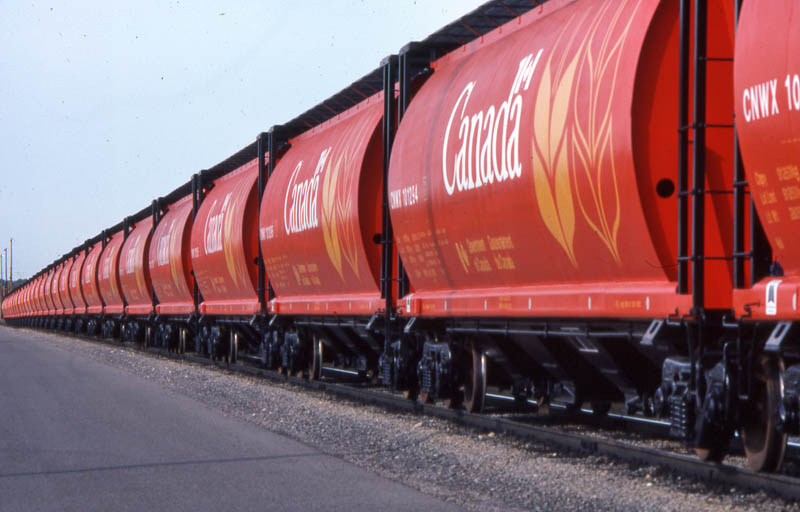
Brand new cars from MIL, Sorel, QC., being moved for delivery to the Prairies by CNR. Walkley yard, by pass track Ottawa
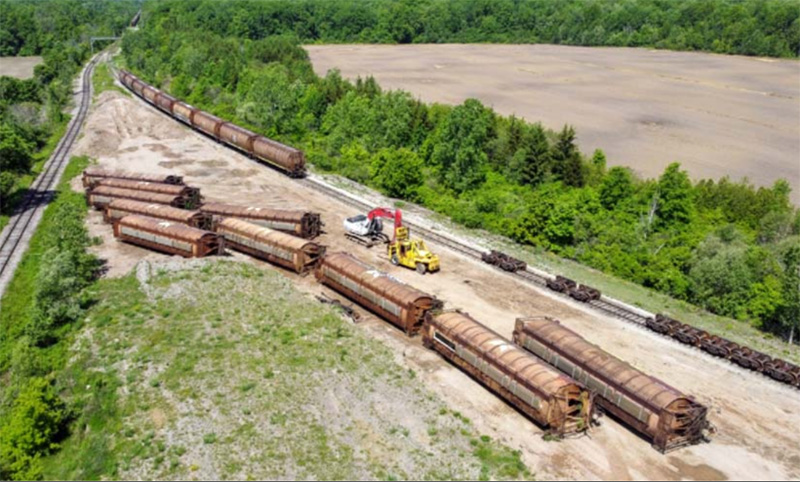
Government of Canada Hopper Cars being scrapped at Welland, Ont., 2021 Joseph Bishop photo
The Beginning by Colin J. Churcher
I
was responsible for "buying" a large proportion of the government grain
hopper fleet while working in grain transportation for Transport Canada
(1975-1986).
The bulk of the brown and yellow fleet as well as all the red and black cars were purchased by the federal government (13,500 cars).
The Canadian Wheat Board acquired 4,000 brown and yellow cars. The
provinces of Saskatchewan and Alberta each bought 1,000 cars. The brown
and yellow scheme was chosen by Otto Lang, then Minister Responsible
for the Canadian Wheat Board, as being non-partisan. The red and black
scheme was chosen by Senator Argue, a later Minister Responsible for
the Canadian Wheat Board.
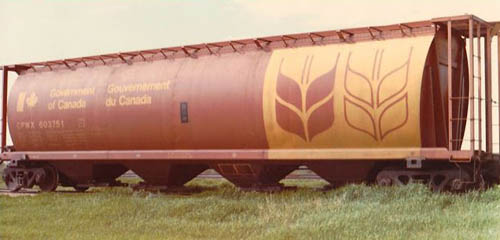
Original Government of Canada scheme
Photo thanks to Eric Gagnon | 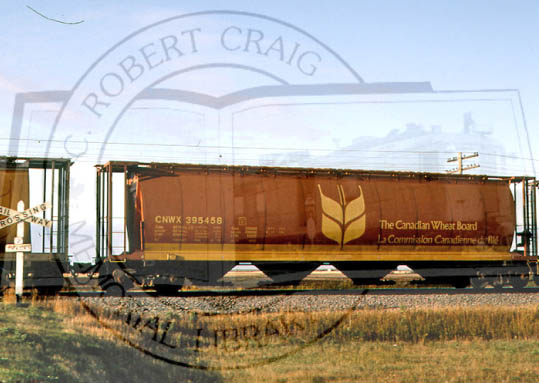
Canadian Wheat Board scheme.
Ken Healy photo.C. Robert Craig Memorial Library 38010
|
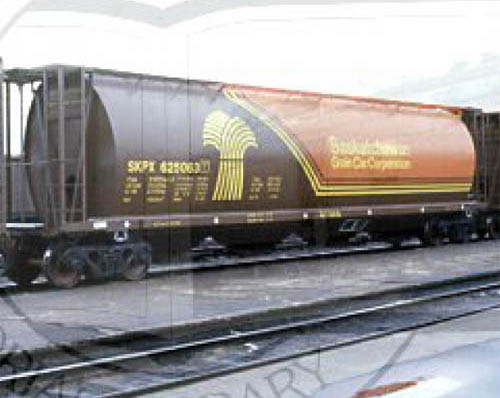
Original livery Saskatchewan car at Smiths Falls
Bruce Chapman collection C. Robert Craig Memorial Library No. 62379 | 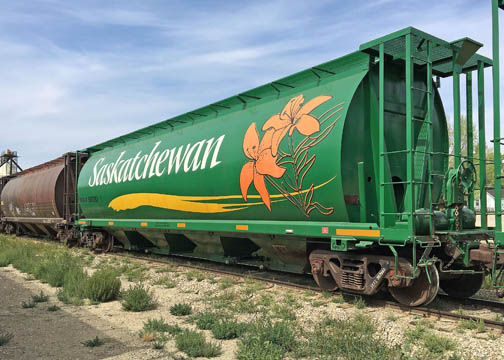
Second livery Saskatchewan car at beechy, SK. on 25 August 2018
Raymond Farand photo
|
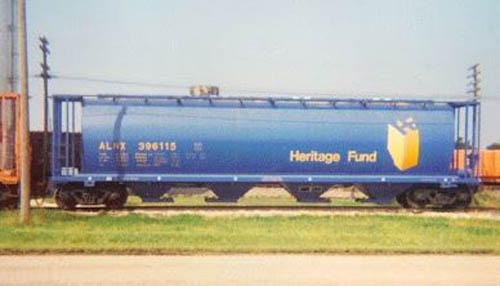
Alberta. Photo thanks to Eric Gagnon |
The steel hoppers were put into
service very quickly and were praised at the time for their greater
capacity and lower center of gravity with their four unloading hoppers.
Initial problems were experienced both on the prairies and at the
ports.
On the prairies the country elevators had to be
modified with higher loading spouts. A number of elevator
managers fell into the hoppers through the top hatches and could not
get out on their own. We solved this by putting a grating over the
opening.
Another problem experienced by the prairie elevator
managers was that the hopper cars with roller bearings ran much more
easily than the journal bearing boxcars they replaced. The elevator
operators asked that the cars be modified to have a hand brake
operating wheel on both ends of the car. This was rejected by the
railways as causing potential operating problems
At the ports
some difficulty was experienced in opening the discharge gates.
Some gates even became so stiff that they had to be cut off to allow
unloading. Eventually the gates were modified to a more satisfactory
system which could be operated with mechanical assistance.
One
of the problems experienced with the steel hoppers was harmonic motion.
The distance between the leading wheel of the front truck and the
leading wheel of the rear truck was forty feet. This was the same as
the rail lengths before extensive use of continuous welded rail.
With rail staggered joints a dangerous harmonic motion could develop.
For this reason trains which had these cars in the consist could not be
operated between 18 mph and 22 mph (I believe this was the range).
Engineers were only allowed to accelerate or decelerate their trains
through this speed range. There was another danger range around 60-70
mph I believe.
Jerry Pinkepank writes: The rock and roll issue was dealt with by constant contact side bearings https://www.youtube.com/watch?v=IeMEKu8HLFQ
which were available in the early 80’s and I suspect they were
retrofitted on these cars. The 60-70mph problem would have been truck
hunting and the constant contact side bearings also deal with
that. I suspect the elimination of these cars from the fleet is
due to the move to 286,00 lb. and 316,000 lb. gross rail load cars in
place of the 263,000lb car prevailing in the early 80’s. This has
also culled 263,000lb cars out of the coal fleets.--Jerry
Some
time after I was called to testify before the Anti-Dumping Tribunal. It
turned out that we were buying some parts (wheels, I believe) from
Brazil that were cheaper, including transportation to Nova Scotia, than
they could be manufactured in the Trenton plant. I heard nothing
further.
The CNR line to Churchill
For
similar reasons CNR would not allow these hoppers to be used on the
line to Churchill, which was always difficult because much of it was
laid on permafrost. This was why the federal government agreed to
renovate a number of 40 foot boxcars for use on the line to Churchill.
It should be noted that when the Churchill line was privatized hopper
cars did make it to Churchill.
Transport Canada also funded the
construction of an articulated car which might have performed well on
the line to Churchill. However development did not go any further
than the prototype.
The Aluminum Cars
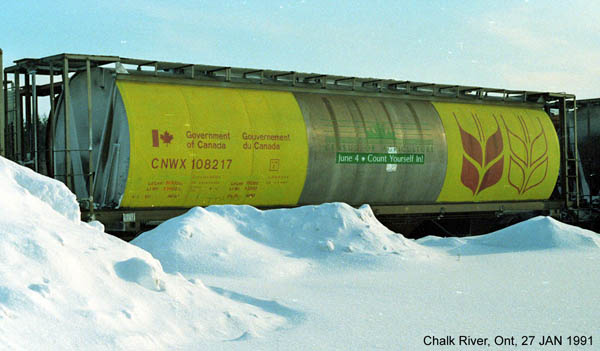
William A. Crago photo.
Ordering the Cars
The
government cars were built in several orders. We obtained prices
and delivery from the three suppliers, National Steel Car, Hamilton,
Ont., MIL, Sorel, Que., and Hawker-Siddeley, Trenton, NS. In each case
the cabinet decided to spread the order rather than choosing the lowest
cost from one manufacturer.
Northern Alberta Railway
In
the mid-1970s the Northern Alberta Railway (NAR) was an independent
line wholly owned by CNR and CPR. Initially neither CNR nor CPR would
allocate hopper cars to the NAR and I began negotiations for the NAR to
have its own separate allocation. There was talk in Edmonton of a
separate NAR livery. However, in the end I was able to persuade CNR
and CPR to allocate hopper cars to the NAR from within their own
allocation.
My
discussions with Jim Pitts, the NAR General Manager covered a wide
range of subjects as well as hopper cars. One of the outcomes was
to name the NAR locomotives in a manner similar to locomotives in the
UK.
Using the Cars
The
rationale for buying hopper cars was that the railways were losing
money moving grain under the statutory Crow’s Nest Pass rates.
Hopper cars were seem as short term assistance until the rate problem
could be resolved. Because if this the government cars could only be
used by the railways to move grain moving at the Crow Rate. This
restricted their use to wheat, oats, barley, rye, rape (canola) and
flax moving from the prairies to Thunder Bay, (Churchill) and the west
coast ports for export. This did apply to grain moving to the Victoria
elevator until it closed but not to domestic points on Vancouver Island.
The
railways were charged whenever a car was used in domestic service. For
many winters there was a heavy movement of grain in solid trains of
hopper cars east of Thunder Bay to Montreal and Halifax (and possibly
Saint John, NB.). These were made under an agreed payment with the
government for their use. This was lucrative traffic for CNR and CPR.
The two railways originally agreed to split the traffic by number of
trains. CPR stole a march on CNR by running 99 car trains whereas
CNR was only able to run trains of 98 cars. Over the winter this
resulted in a significant financial advantage to CPR.
The hopper
cars were occasionally used for non-grain movements with payment to the
government. For example they were used by CPR to move drilling mud to
Alberta.
One of the pleasures of my job at that time was
to attend the sample car inspections. At the commencement of each
order the manufacturer would complete one car and the railway
mechanical people would go over that car in fine detail to ensure that
it conformed to the plans. The car was then kept at the plant so that
if there were any problems later on in the production process these
could be verified by reference to the approved model. Here are
two pictures I took at Hamilton in August 1982.
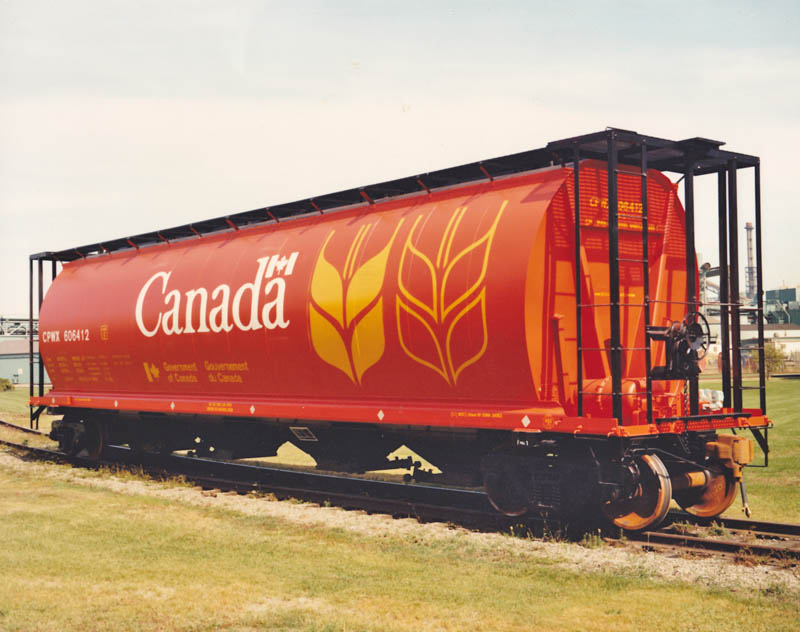
Sample car ar National Steel Car, Hamilton, August 1982.

Sample Car at National Steel Car, Hamiltom. August 1982
From left to right John Nelham, NSC; Paul Churcher; Colin Churcher
The Demise of the Government Cars
The decomissioning of the cars was not straight forward as Bernie Geiger remembers (June 2021)
The
disposal of the cars was not straight forward as the government laws
and policy requirements have complex approval and reporting
requirements to write-off and / or transfer to other operators.
There was some Central Agency discussion as to whether the actions
could be reported as groups of cars in the Public Accounts or
individual numbers needed to be given for each individual car.
I remember it was often difficult to "donate"
federal government items to museums because you had to adhere to
various disposal requirements and there is really no easy way to "gift"
something like a (railway) artifact, image, souvenir, etc to a museum
or library.
Perhaps it was easiest to throw it in the
"garbage" and tell someone to pick it out of the garbage before it was
hauled away.









